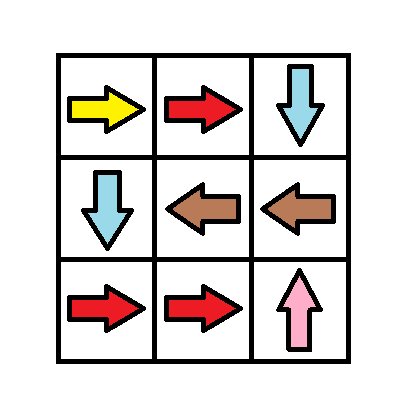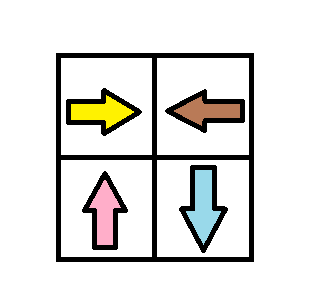1485. Minimum Cost To Make At Least One Valid Path In A Grid¶
Difficulty: Hard
LeetCode Problem View on GitHub
1485. Minimum Cost to Make at Least One Valid Path in a Grid
Hard
Given an m x n grid. Each cell of the grid has a sign pointing to the next cell you should visit if you are currently in this cell. The sign of grid[i][j] can be:
1which means go to the cell to the right. (i.e go fromgrid[i][j]togrid[i][j + 1])2which means go to the cell to the left. (i.e go fromgrid[i][j]togrid[i][j - 1])3which means go to the lower cell. (i.e go fromgrid[i][j]togrid[i + 1][j])4which means go to the upper cell. (i.e go fromgrid[i][j]togrid[i - 1][j])
Notice that there could be some signs on the cells of the grid that point outside the grid.
You will initially start at the upper left cell (0, 0). A valid path in the grid is a path that starts from the upper left cell (0, 0) and ends at the bottom-right cell (m - 1, n - 1) following the signs on the grid. The valid path does not have to be the shortest.
You can modify the sign on a cell with cost = 1. You can modify the sign on a cell one time only.
Return the minimum cost to make the grid have at least one valid path.
Example 1:

Input: grid = [[1,1,1,1],[2,2,2,2],[1,1,1,1],[2,2,2,2]] Output: 3 Explanation: You will start at point (0, 0). The path to (3, 3) is as follows. (0, 0) --> (0, 1) --> (0, 2) --> (0, 3) change the arrow to down with cost = 1 --> (1, 3) --> (1, 2) --> (1, 1) --> (1, 0) change the arrow to down with cost = 1 --> (2, 0) --> (2, 1) --> (2, 2) --> (2, 3) change the arrow to down with cost = 1 --> (3, 3) The total cost = 3.
Example 2:

Input: grid = [[1,1,3],[3,2,2],[1,1,4]] Output: 0 Explanation: You can follow the path from (0, 0) to (2, 2).
Example 3:

Input: grid = [[1,2],[4,3]] Output: 1
Constraints:
m == grid.lengthn == grid[i].length1 <= m, n <= 1001 <= grid[i][j] <= 4
Solution¶
class Solution {
static class Pair {
int row, col, val,cost;
public Pair(int row, int col,int val,int cost) {
this.row = row;
this.col = col;
this.val = val;
this.cost = cost;
}
}
public int minCost(int[][] grid) {
return bfs(0, 0, grid);
}
public static int bfs(int row, int col, int grid[][]) {
int n = grid.length;
int m = grid[0].length;
int dir[][] = {{-1, 0} , {1, 0} , {0, -1} , {0 , 1}};
Queue<Pair> q = new LinkedList<>();
int dist[][] = new int[n + 1][m + 1];
for(int current[] : dist) Arrays.fill(current, (int)(1e9));
dist[0][0] = 0;
q.offer(new Pair(0,0,grid[0][0],0));
int min = Integer.MAX_VALUE;
while(!q.isEmpty()) {
int cr = q.peek().row;
int cc = q.peek().col;
int cv = q.peek().val;
int ccost = q.peek().cost;
System.out.println(cr + " " + cc + " " + ccost);
if(cr == n - 1 && cc == m - 1) min = Math.min(min, ccost);
q.poll();
if(cv == 1) {
int nr = cr;
int nc = cc + 1;
if(nc < m) {
if(dist[nr][nc] > ccost) {
q.offer(new Pair(nr, nc, grid[nr][nc] , ccost));
dist[nr][nc] = ccost;
}
}
}
if(cv == 2) {
int nr = cr;
int nc = cc - 1;
if(nc >= 0) {
if(dist[nr][nc] > ccost) {
q.offer(new Pair(nr, nc, grid[nr][nc] , ccost));
dist[nr][nc] = ccost;
}
}
}
if(cv == 3) {
int nr = cr + 1;
int nc = cc;
if(nr < n) {
if(dist[nr][nc] > ccost) {
q.offer(new Pair(nr, nc, grid[nr][nc] , ccost));
dist[nr][nc] = ccost;
}
}
}
if(cv == 4) {
int nr = cr - 1;
int nc = cc;
if(nr >= 0) {
if(dist[nr][nc] > ccost) {
q.offer(new Pair(nr, nc, grid[nr][nc] , ccost));
dist[nr][nc] = ccost;
}
}
}
for(int dire[] : dir) {
int nr = cr + dire[0];
int nc = cc + dire[1];
if(nr >= 0 && nr < n && nc >= 0 && nc < m) {
if(dist[nr][nc] > ccost + 1) {
q.offer(new Pair(nr, nc, grid[nr][nc] , ccost + 1));
dist[nr][nc] = ccost + 1;
}
}
}
}
return Math.min(min, dist[n - 1][m - 1]);
}
}
Complexity Analysis¶
- Time Complexity:
O(?) - Space Complexity:
O(?)
Approach¶
Detailed explanation of the approach will be added here